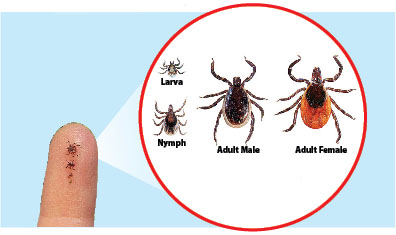
grassy areas.
Nassau University Medical Center President/CEO Dr. Victor Politi was recently joined by health officials at a press conference at the Nassau University Medical Center to warn of a recent explosion of disease-breeding ticks on Long Island that can cause severe illness and prolonged health damage, including cognitive damage, and if untreated, even death.
The hospital has set up treatment areas for people who suspect they have been bitten by ticks. The bites cause Lyme disease.
New York State has the highest number of Lyme disease cases in the country, according to the Centers for Disease Control and Prevention (CDC). The CDC has recorded more than 95,000 Lyme infections in the state since 1986. Long Island has been particularly hard-hit in recent years, because of its many wooded areas.
Ticks that can spread Lyme disease are now present in almost half of the counties in the United States, compared with only 30 percent 20 years ago.
Common symptoms can include fever, headache and fatigue, all of which can be confused for flu. Early diagnosis can be treated with antibiotics, but untreated Lyme disease can lead to long-term cognitive problems, joint and muscle pain and mood disorders. Lyme disease can be deadly if untreated.
The tick infestation is a result of climate change, an unusually short and warm winter, and oak trees that produced a huge number of acorns last fall.
 The most common symptoms of tick-related illnesses are:
The most common symptoms of tick-related illnesses are:
Fever/chills
With all tickborne diseases, patients can experience fever at varying degrees and time of onset.
Aches and pains
Tickborne disease symptoms include headache, fatigue, and muscle aches. With Lyme disease, you may also experience joint pain. The severity and time of onset of these symptoms can depend on the disease and the patient’s personal tolerance level.
Rash
In Lyme disease, the rash may appear within 3-30 days, typically before the onset of fever. The Lyme disease rash is the first sign of infection and is usually a circular rash called erythema migrans (EM). This rash occurs in approximately 70 to 80 percent of infected persons and begins at the site of a tick bite. It may be warm, but is not usually painful. Some patients develop additional EM lesions in other areas of the body several days later.
Tickborne diseases can result in mild symptoms treatable at home to severe infections requiring hospitalization. Although easily treated with antibiotics, these diseases can be difficult for physicians to diagnose. However, early recognition and treatment of the infection decreases the risk of serious complications. So see your doctor immediately if you have been bitten by a tick and experience any of the symptoms described here.
Take Steps To Protect Against Ticks
Taking steps to protect yourself and your family from getting a tick bite is the best defense against Lyme disease and other tickborne infections. Whether you’re working, enjoying your yard, camping, hiking, hunting or otherwise in the outdoors, CDC recommends that people:
• Avoid areas with high grass and leaf litter and walk in the center of trails when hiking.
• Use repellent that contains 20 percent or more DEET, picaridin, or IR3535 on exposed skin for protection that lasts several hours.
• Use products that contain permethrin to treat clothing and gear, such as boots, pants, socks and tents or look for clothing pre-treated with permethrin.
• Treat dogs for ticks. Dogs are very susceptible to tick bites and to some tickborne diseases. They may also bring ticks into your home. Tick collars, sprays, shampoos or monthly “top spot” medications help protect against ticks.
• Bathe or shower as soon as possible after coming indoors to wash off and more easily find crawling ticks before they bite you.
• Conduct a full-body tick check using a hand-held or full-length mirror to view all parts of your body upon returning from tick-infested areas. Parents should help children check thoroughly for ticks. Remove any ticks right away.
• Tumble dry clothes in a dryer on high heat for 10 minutes to kill ticks on dry clothing after you come indoors. If the clothes are damp, additional time may be needed.


















